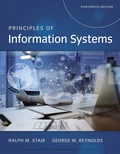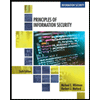
Principles of Information Systems (MindTap Course List)
13th Edition
ISBN: 9781337516945
Author: STAIR
Publisher: Cengage
expand_more
expand_more
format_list_bulleted
Expert Solution & Answer
Chapter 4.4, Problem 2CTQ
Explanation of Solution
Actions for reducing the given risks:
The following actions are used for reducing the risks which are associated with the use of any new software that is designed to replace manual procedures.
- The IS (
Information system ) team and each department manager need to fully communicate with employees...
Expert Solution & Answer
Want to see the full answer?
Check out a sample textbook solution
Students have asked these similar questions
Please original work
In the progression from raw data to actionable knowledge, business analysts play a crucial role in transforming and interpreting data to support strategic decision-making.
What do you think are the most important skills a business analyst needs to effectively navigate the transition from data to information and then to knowledge?
How can organizations ensure that analysts are equipped to extract meaningful insights that drive informed decisions? Share examples or insights from your own experiences or studies.
Please cite in text references and add weblinks
Research enterprise network services commonly performed by Linux servers. Choose 3 and describe their function, as well as why they are typically set up on Linux machines.
The term color tone refers to the "temperature" of a photo.
Question 17Select one:
True
False
Chapter 4 Solutions
Principles of Information Systems (MindTap Course List)
Ch. 4.1 - Prob. 1RQCh. 4.1 - Prob. 2RQCh. 4.1 - Prob. 1CTQCh. 4.1 - Prob. 2CTQCh. 4.2 - Prob. 1RQCh. 4.2 - Prob. 2RQCh. 4.2 - Prob. 1CTQCh. 4.2 - Prob. 2CTQCh. 4.3 - Prob. 1RQCh. 4.3 - Prob. 2RQ
Ch. 4.3 - Prob. 1CTQCh. 4.3 - Prob. 2CTQCh. 4.4 - What is the primary difference between purchasing...Ch. 4.4 - What are the pros and cons of using open-source...Ch. 4.4 - What risks and start-up issues are associated with...Ch. 4.4 - Prob. 2CTQCh. 4 - Prob. 1SATCh. 4 - Prob. 2SATCh. 4 - Prob. 3SATCh. 4 - Prob. 4SATCh. 4 - Prob. 5SATCh. 4 - Prob. 6SATCh. 4 - Prob. 7SATCh. 4 - Prob. 8SATCh. 4 - Prob. 9SATCh. 4 - Prob. 10SATCh. 4 - ______ is software that makes its source code...Ch. 4 - Software ______ are an important source of...Ch. 4 - Identify and briefly discuss the three spheres of...Ch. 4 - Prob. 2RQCh. 4 - Prob. 3RQCh. 4 - What is the kernel of the operating system?Ch. 4 - Prob. 5RQCh. 4 - Prob. 6RQCh. 4 - Prob. 7RQCh. 4 - Prob. 8RQCh. 4 - Prob. 9RQCh. 4 - Distinguish between proprietary software and...Ch. 4 - Prob. 11RQCh. 4 - Prob. 12RQCh. 4 - Prob. 13RQCh. 4 - Prob. 14RQCh. 4 - Prob. 15RQCh. 4 - Prob. 16RQCh. 4 - Prob. 1DQCh. 4 - Assume that you must take a computer-programming...Ch. 4 - Prob. 3DQCh. 4 - Prob. 4DQCh. 4 - Prob. 5DQCh. 4 - Prob. 6DQCh. 4 - Prob. 7DQCh. 4 - Prob. 8DQCh. 4 - Prob. 9DQCh. 4 - Prob. 10DQCh. 4 - Prob. 1PSECh. 4 - Prob. 2PSECh. 4 - Prob. 3PSECh. 4 - Prob. 1TACh. 4 - Prob. 1WECh. 4 - Do research on the Web to learn which programming...Ch. 4 - Prob. 3WECh. 4 - Prob. 1CECh. 4 - Prob. 2CECh. 4 - Think of your ideal job. Identify two existing...Ch. 4 - Prob. 1CTQ1Ch. 4 - Prob. 2CTQ1Ch. 4 - Prob. 3CTQ1Ch. 4 - Prob. 1CTQ2Ch. 4 - Prob. 2CTQ2Ch. 4 - Prob. 3CTQ2
Knowledge Booster
Similar questions
- You cannot add 3-dimensional effects to a shape. Question 18Select one: True Falsearrow_forwardWhich gallery shows available shapes for WordArt text? Question 10Select one: a. Transform b. Shape Styles c. Themes d. WordArt Stylesarrow_forwardWhen you press [Shift][Ctrl] while dragging a corner sizing handle on a graphic, the graphic is ____. Question 9Select one: a. resized while keeping the center position fixed and maintaining its proportions b. resized proportionally c. re-positioned diagonally d. resized diagonally while changing proportionallyarrow_forward
- What is the term used to describe trimming away part of a graphic to expose only some of it? Question 8Select one: a. Resizing b. Hiding c. Cropping d. Scalingarrow_forwardTo insert a SmartArt graphic in a document, click the SmartArt button in the _____ group on the Insert tab. Question 6Select one: a. Text b. Shapes c. Illustrations d. Pagesarrow_forwardBriefly define and discuss the following classes of problems: P, NP, NP-Complete, co-NP, NC, P-Complete.arrow_forward
- A3Q3.c - You are to write a C program that implements the following disk scheduling algorithms: a. FCFS [10 marks] b. SCAN [10 marks] c. C-SCAN [10 marks] d. SSTF [10 marks] e. LOOK [10 marks] f. C-LOOK [10 marks] • Your program will service a disk with 300 cylinders numbered 0 to 299. • • • • The program will service the requests (a list of 20 cylinder numbers) given in the file request.bin. This file contains (4 byte) integer values representing requests ranging from 0-299. Your program will take the initial position of the disk head as the first command line argument and the direction of the head as the second command line argument. It will then output the requests in the order in which they are serviced, and the total amount of head movements required by each algorithm. In particular, your program needs to do the following: Your program should take two command line arguments a) First command line argument - initial position of the disk head (an integer value) b) Second command line…arrow_forward2. The memory management has contiguous memory allocation, dynamic partitions, and paging. Compare the internal fragmentation and external fragmentation for these three approaches. [2 marks] 3. Suppose we have Logical address space = 24 = 16 (m = 4), Page size=2² =4 (n = 2), Physical address space = 26 = 64 (r = 6). Answer the following questions: [4 marks] 1) Total # of pages ? 2) Total # of frames ? 3) Number of bits to represent logical address? 4) Number of bits to represent offset ? 5) Number of bits to represent physical address? 6) Number of bits to represent a page number? 7) Number of bits to represent a frame number / 4. What is translation look-aside buffers (TLBS)? Why we need them to implement the page table? [2 marks] 5. Why we need shared pages for multiple processes? Give one example to show the benefits. [2 marks] 6. How to implement the virtual memory by using page out and page in? Explain with an example. [2 marks] 7. We have a reference string of referenced page…arrow_forward8. List three HDD scheduling algorithms. [2 marks] 9. True or False? The NVM has the same scheduling algorithms with HDD. Explain why? [2 marks] 10. Why the modern mouses use polling to detect movements instead of interrupts? [2 marks] 11. What is thrashing? How does it happen? [2 marks] 12. Given a reference string of page numbers 7, 0, 1, 2, 0, 3, 0, 4, 2, 3, 0, 3, 0, 3, 2, 1, 2, 0, 1, 7, 0, 1 and 4 frames show how the page replacement algorithms work, and how many page faults? [6 marks], 1) FIFO algorithm? [2 marks] 2) Optimal algorithm? [2 marks] 3) LRU algorithm? [2 marks] 13. List at least three file systems that you know. [2 marks] 14. In C programming, how the seek to a specific position in the file by offset? [2 marks]arrow_forward
- Is developed App in play store much easier than in app store because i look app like human anonymus and like walter labs prioritize iphone app store first is it difficult to developed app on play store ? And btw i want to move to iphone anroid suckarrow_forwardQ12- A three phase transformer 3300/400 V,has D/Y connected and working on 50Hz. The line current on the primary side is 12A and secondary has a balanced load at 0.8 lagging p.f. Determine the i) Secondary phase voltage ii) Line current iii) Output power Ans. (230.95 V, 99.11 A, 54.94 kW)arrow_forwardmake corrections of this program based on the errors shown. this is CIS 227 .arrow_forward
arrow_back_ios
SEE MORE QUESTIONS
arrow_forward_ios
Recommended textbooks for you
 Principles of Information Systems (MindTap Course...Computer ScienceISBN:9781305971776Author:Ralph Stair, George ReynoldsPublisher:Cengage Learning
Principles of Information Systems (MindTap Course...Computer ScienceISBN:9781305971776Author:Ralph Stair, George ReynoldsPublisher:Cengage Learning Fundamentals of Information SystemsComputer ScienceISBN:9781337097536Author:Ralph Stair, George ReynoldsPublisher:Cengage Learning
Fundamentals of Information SystemsComputer ScienceISBN:9781337097536Author:Ralph Stair, George ReynoldsPublisher:Cengage Learning Principles of Information Systems (MindTap Course...Computer ScienceISBN:9781285867168Author:Ralph Stair, George ReynoldsPublisher:Cengage Learning
Principles of Information Systems (MindTap Course...Computer ScienceISBN:9781285867168Author:Ralph Stair, George ReynoldsPublisher:Cengage Learning Management Of Information SecurityComputer ScienceISBN:9781337405713Author:WHITMAN, Michael.Publisher:Cengage Learning,
Management Of Information SecurityComputer ScienceISBN:9781337405713Author:WHITMAN, Michael.Publisher:Cengage Learning, Principles of Information Security (MindTap Cours...Computer ScienceISBN:9781337102063Author:Michael E. Whitman, Herbert J. MattordPublisher:Cengage Learning
Principles of Information Security (MindTap Cours...Computer ScienceISBN:9781337102063Author:Michael E. Whitman, Herbert J. MattordPublisher:Cengage Learning Information Technology Project ManagementComputer ScienceISBN:9781337101356Author:Kathy SchwalbePublisher:Cengage Learning
Information Technology Project ManagementComputer ScienceISBN:9781337101356Author:Kathy SchwalbePublisher:Cengage Learning

Principles of Information Systems (MindTap Course...
Computer Science
ISBN:9781305971776
Author:Ralph Stair, George Reynolds
Publisher:Cengage Learning

Fundamentals of Information Systems
Computer Science
ISBN:9781337097536
Author:Ralph Stair, George Reynolds
Publisher:Cengage Learning

Principles of Information Systems (MindTap Course...
Computer Science
ISBN:9781285867168
Author:Ralph Stair, George Reynolds
Publisher:Cengage Learning

Management Of Information Security
Computer Science
ISBN:9781337405713
Author:WHITMAN, Michael.
Publisher:Cengage Learning,

Principles of Information Security (MindTap Cours...
Computer Science
ISBN:9781337102063
Author:Michael E. Whitman, Herbert J. Mattord
Publisher:Cengage Learning

Information Technology Project Management
Computer Science
ISBN:9781337101356
Author:Kathy Schwalbe
Publisher:Cengage Learning